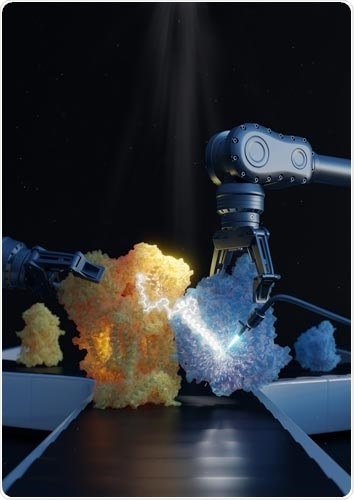Mitochondrial diseases exhibit different symptoms like muscle weakness, severe fatigue, even blindness. Most genetic diseases are the result of mitochondrial defects. Thorough knowledge of these “powerhouses” of cells is hence vital for the generation of novel treatments.

When assembled into a supercomplex, the two parts of CIII2CIV are held together by a molecule that acts like a fishhook. This optimizes the cell metabolism. Image Credit: © Verena Resch Luminous Lab/IST Austria.
Scientists from the Institute of Science and Technology (IST) Austria for the first time have illustrated the structure of a protein complex crucial for their work. The research was published in the Nature journal.
Cells require energy to fulfill their many tasks. Mitochondria, the cell’s power plants convert the energy present in the food to ATP molecules. ATP acts as a fuel that urges most cellular mechanisms—from muscle contraction to the assembly of DNA. Professor Leonid Sazanov and Irene Vercellino are the first researchers to accurately illustrate how a protein assembly necessary for this mechanism looks like in mammalian cells.
Like a fishhook
Irene Vercellino, first author and Professor Sazanov employed cryo-electron microscopy—a technique that enables scientists to observe extremely small samples in their natural state—and displayed the precise structure of the so-called supercomplex CIII2CIV.
This assembly of protein building blocks pumps charged particles, protons, through the mitochondrial membrane, which is required to begin the energy conversion mechanism in the cells. Hence, it accomplishes a function similar to that of the starter battery of cars.
To date, this supercomplex was elaborated in plant and yeast cells where it attains a very distinct form, as the scientists recently revealed. To comprehend the precise mechanism of energy production in animal cells, the researchers analyzed sheep and mice cells and were astonished.
Nobody could have predicted the way SCAF1 acts.”
Leonid A. Sazanov, Professor, Institute of Science and Technology Austria
Previous studies already showed that the molecule SCAF1 plays a role in assembling the two protein complexes that together form supercomplex CIII2CIV. Instead of interacting with the two protein complexes on the surface only, the molecule goes deep inside complex III while being attached to complex IV.
It is like a hook swallowed by a fish. Once it’s swallowed it can’t get out.”
Leonid A. Sazanov, Professor, Institute of Science and Technology Austria
Close, but not too close
Moreover, the researchers demonstrated that the supercomplex CIII2CIV adapts two different forms – a locked and an unlocked or mature one.
In its locked state some parts of complex III are still missing and the interaction between the two complexes is very intimate.”
Leonid A. Sazanov, Professor, Institute of Science and Technology Austria
Upon complete assembly, however, the two complexes are linked by SCAF1 without getting in each other’s way. The Belarusian-British scientist presumes, “In order to fulfill its tasks, complex III probably prefers to be free from interference in its movements.”
Assemblage into a supercomplex, conversely, enhances their chemical reactions, which proves advantageous for the animal. It was observed that mice and zebrafish lacking the SCAF1 molecule are substantially smaller, least fertile, and least fit.
Vercellino and Sazanov, in their current research, elaborated on the molecule’s role in forming supercomplex CIII2CIV, which optimizes cellular metabolism. This was the last piece of the puzzle—along with their earlier researches, Sazanov and his group have currently estimated the structures of all supercomplexes in mammalian mitochondria. The researchers are thus setting the foundation for novel treatments for mitochondrial disease.
Source:
Journal reference:
Vercellino, I., & Sazanov, L. A. (2021) Structure and assembly of the mammalian mitochondrial supercomplex CIII2CIV. Nature. doi.org/10.1038/s41586-021-03927-z.